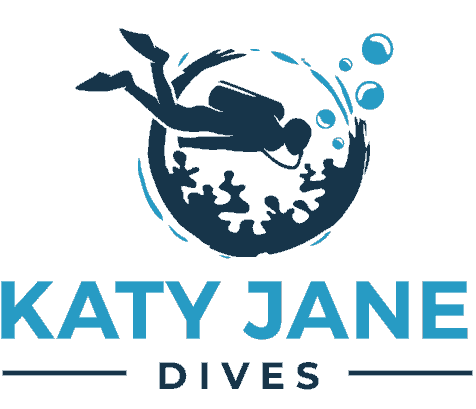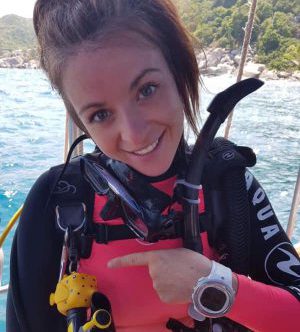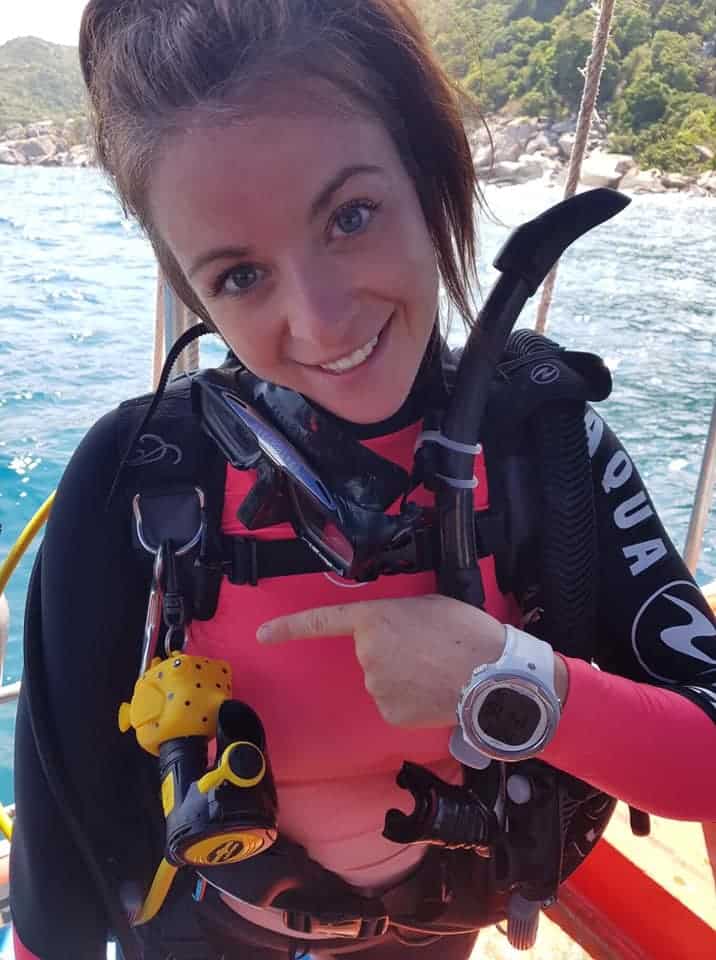For any diver with a bucket list, the Galapagos is not just a recommendation; it’s a call to adventure, a must-experience haven that promises to transform your very essence as a diver.
Embarking on a 7-day liveaboard journey on the Galaxy Diver around the enchanting Galapagos Islands, I was swept into a world where the underwater marvels far exceeded my wildest dreams.
Join me on a journey through this guide to the best diving spots in the Galapagos Islands, as we uncover the underwater wonders that make this destination a diver’s dream come true.
Table of Contents
Quick Look
- Darwins Arch/Darwins Pillars
- Shark Bay
- Gordon Rocks
- Cape Marshall
- Camaño Islet
- The Landslide/El Derrumbe
- Punta Vicente Roca
- North Seymour
- Cousins Rock
- Roca Redonda
- Bartholomew Point
- Kicker Rock
- Daphne Major
- Whale Rock
Best Dive Sites in the Galapagos Islands
The Galapagos Islands are known to host some of the world’s most exquisite dive sites, offering a once-in-a-lifetime underwater experience.
Each dive site, with its unique marine life and underwater features, contributes to the islands’ reputation for top-notch diving.
This trip wasn’t just another dive; it was a pilgrimage to one of the planet’s most revered diving sanctuaries. Every moment spent beneath the waves was a vivid testament to the islands’ unparalleled beauty and biodiversity.
Darwins Arch/Darwins Pillars
- Location: South-east of Darwin Island in the Galápagos Archipelago
- Perfect For: Advanced Open Water Diver
- Likely to See: Hammerhead sharks, sea turtles, dolphins and abundant species of fish
- Temperature: 20 to 25 degrees Celsius (68 to 77 degrees Fahrenheit)
- Visibility: 30 meters (100 feet) or more
- Depth: 18 to 30 meters (60 to 100 feet)
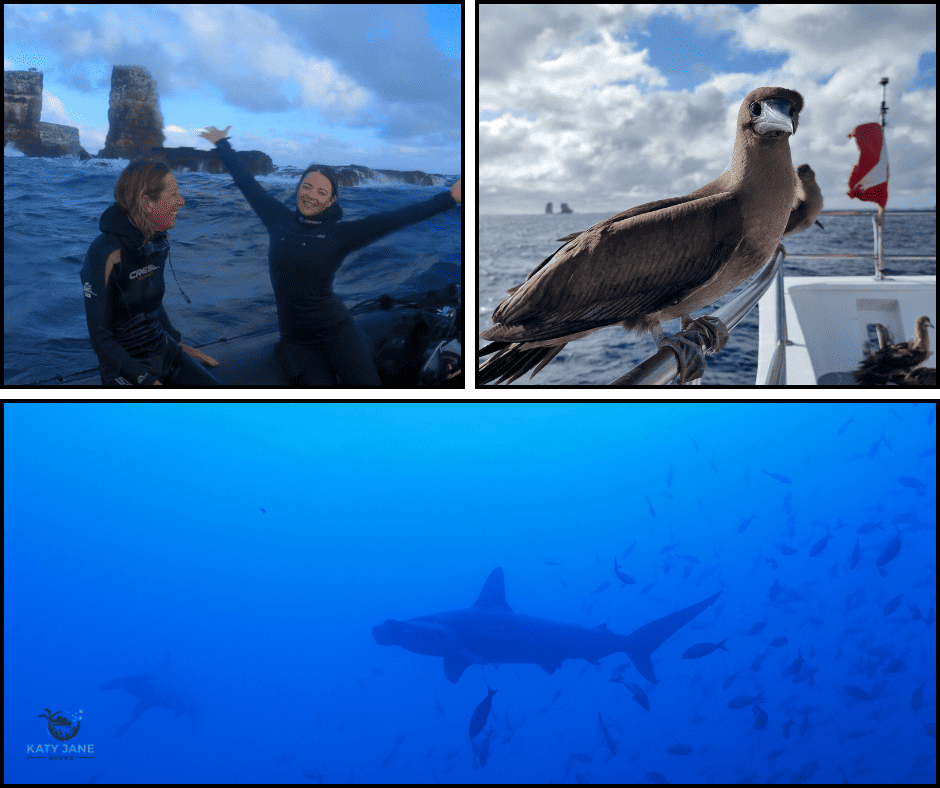
Darwin’s Arch, also known as Darwin’s Pillars, stands as a testament to the raw beauty and exhilaration of diving in the Galapagos.
Here, divers can expect water temperatures ranging from approximately 20 to 25 degrees Celsius (68 to 77 degrees Fahrenheit), making it ideal for comfortable diving in a wetsuit or drysuit. The depth at Darwin’s Pillars typically ranges from 18 to 30 meters (60 to 100 feet), allowing for both recreational and advanced diving experiences.
As for visibility, divers are often treated to crystal-clear waters with visibility extending up to 30 meters (100 feet) or more, offering stunning views of the diverse marine life and underwater topography.
My six dives at this iconic site were not merely explorations but a journey into what became my favourite diving experience in the archipelago. The sheer abundance and variety of marine life here are unparalleled. The memory of a wall of hammerheads emerging from the blue will be etched in my mind forever—an awe-inspiring spectacle of nature’s majesty.
The biodiversity at Darwin’s Arch is breathtaking. Each dive revealed a new layer of this underwater paradise, from schools of sharks that patrol the depths to the turtles that glide serenely by. Pods of dolphins added to the magic, their playful antics a joy to behold.
The diversity of fish species was staggering, a vivid showcase of the Galapagos’s rich marine ecosystem. Encounters with Galapagos sharks and the rare sighting of a tiger shark heightened the sense of adventure and discovery.
Although my trip fell outside the whale shark season, fortune smiled upon us with a rare sighting of one near the surface, a moment of serendipity that underscored the unpredictability and wonder of diving in the Galapagos.
This drift dive near Darwin’s Arch was nothing short of spectacular. As we drifted away from the rocky formations and into the blue, the sense of freedom and exhilaration was overwhelming. This site, with its strong currents, is not just a dive; it’s an immersive experience that challenges and rewards in equal measure.
Darwin’s Arch encapsulates the essence of Galapagos diving—raw, untamed, and utterly unforgettable. It’s a site that not only offers an incredible array of marine life but also serves as a vivid reminder of why we dive: to connect, to explore, and to marvel at the wonders of the underwater world.
Shark Bay
- Location: Wolf Island
- Perfect For: Advanced Open Water Diver
- Likely to See: Sea lions, hammerhead sharks, Galapagos sharks, white tip reef sharks
- Temperature: 20 to 25 degrees Celsius (68 to 77 degrees Fahrenheit)
- Visibility: 30 meters (100 feet) or more
- Depth: 15 to 30 meters (50 to 100 feet)
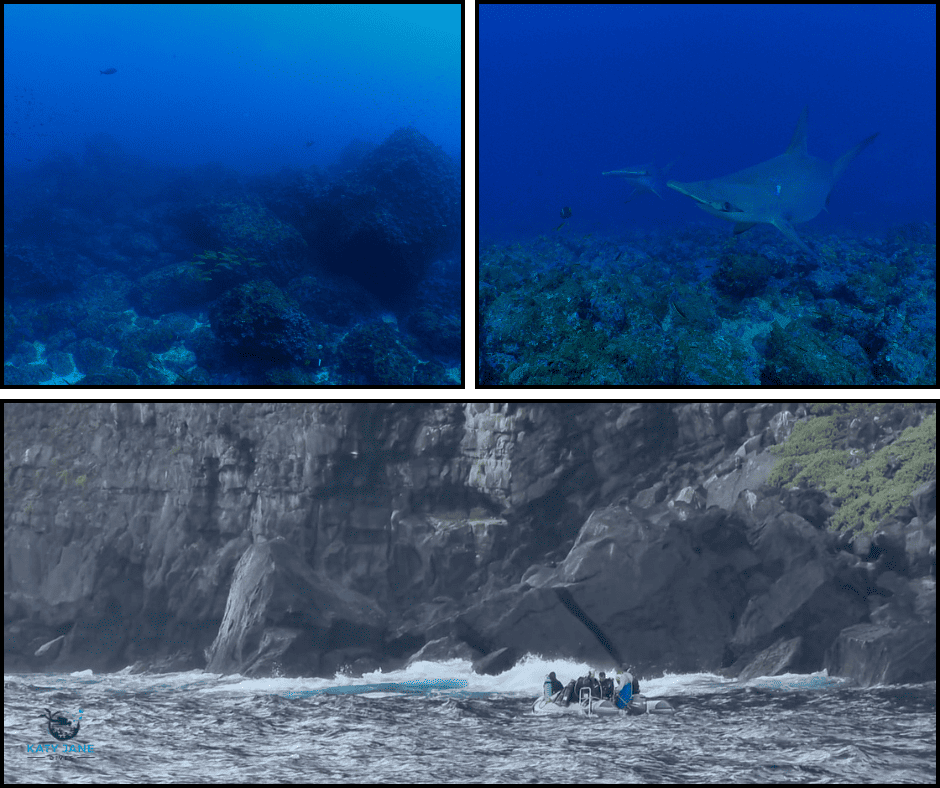
Shark Bay at Wolf Island, emerges as a diving destination of unparalleled allure, beckoning adventurers with its promise of close encounters with the ocean’s most majestic inhabitants.
This dive site, renowned for its strong currents, acts as a magnet for a spectacular array of sharks, setting the stage for an underwater spectacle that is as thrilling as it is unforgettable.
Water temperatures average around 20 to 25 degrees Celsius (68 to 77 degrees Fahrenheit), providing a comfortable environment for diving in wetsuits. With depths ranging from 15 to 30 meters (50 to 100 feet), divers have the opportunity to explore a diverse range of underwater landscapes, from rocky outcrops to sandy bottoms. Visibility in Shark Bay is typically excellent, often reaching up to 30 meters (100 feet) or more, allowing for breathtaking encounters with the abundant marine life, including schools of hammerhead sharks and other pelagic species.
Diving into the depths of Shark Bay, I was greeted by the playful antics of sealions, their graceful movements and curious eyes adding a touch of whimsy to the dive. It was a reminder of the Galapagos’ unique ability to foster connections between humans and marine life, a testament to the archipelago’s untouched beauty and ecological significance.
While challenging, the currents at Shark Bay serve a vital role in the ecological tapestry of the area. These powerful natural forces bring with them a bounty of nutrients, creating a thriving underwater ecosystem. It was these very currents that ushered in an impressive assembly of sharks, a sight that was both awe-inspiring and humbling.
The waters teemed with life, from the sleek silhouettes of hammerhead sharks to the imposing presence of Galapagos sharks, each species contributing to the dynamic and vibrant marine landscape.
Gordon Rocks
- Location: East cost of Santa Cruz Island
- Perfect For: Advanced Open Water Diver
- Likely to See: Hammerhead sharks, manta rays, galapagos sharks, whale sharks and array of reef fish, sea lions and turtles
- Temperature: 18°C (64°F) in the cooler season to 26°C (79°F) during warmer months
- Visibility: 30 meters (100 feet)
- Depth: 9 to 40 meters (30 to 130 feet)
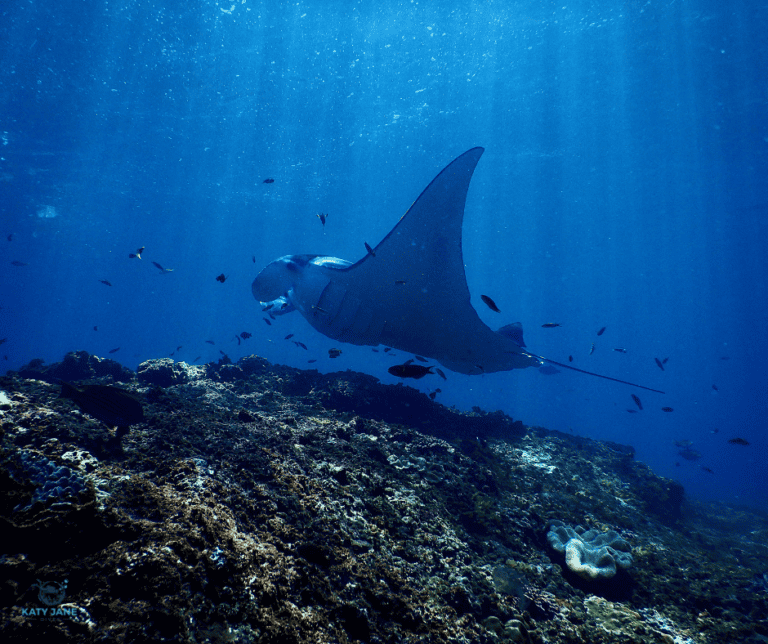
Gordon Rocks, often referred to as “The Washing Machine” due to its swirling currents, is a pinnacle that rises from the ocean floor near the eastern side of Santa Cruz Island in the Galapagos.
Known for its advanced dives, the site boasts depths ranging between 9 to 40 meters (30 to 130 feet) with visibility often extending up to 30 meters (100 feet), depending on the currents and time of year. Water temperatures can vary widely, from 18°C (64°F) in the cooler season to 26°C (79°F) during warmer months, making it advisable for divers to be prepared with appropriate thermal protection.
Renowned for its congregations of scalloped hammerhead sharks, Gordon Rocks is a magnet for divers seeking the thrill of swimming amongst large schools of these magnificent creatures. The site is also home to other pelagic species such as manta rays, Galapagos sharks, and occasionally whale sharks, alongside a vibrant array of reef fish, sea lions, and turtles, offering a quintessential Galapagos diving experience.
While I didn’t have the opportunity to dive at Gordon Rocks myself, feedback from the diving community underscores its reputation as one of the archipelago’s most popular and exhilarating dive sites.
The chance to dive in the midst of hammerhead schools makes it a bucket-list destination for many. Its currents and conditions do demand a higher level of experience, underscoring its appeal to advanced divers seeking to explore the dynamic underwater ecosystems of the Galapagos.
Cape Marshall
- Location: Northeastern coast of Isabela
- Perfect For: Advanced Open Water Diver
- Likely to See: Plankton rich waters, garden of eels, mobula rays, sea turtles and sea lions
- Temperature: 17°C and 23°C (63°F and 73°F)
- Visibility: 3 to 10 meters (10 to 33 feet)
- Depth: 10 to 35 meters (33 to 98 feet)
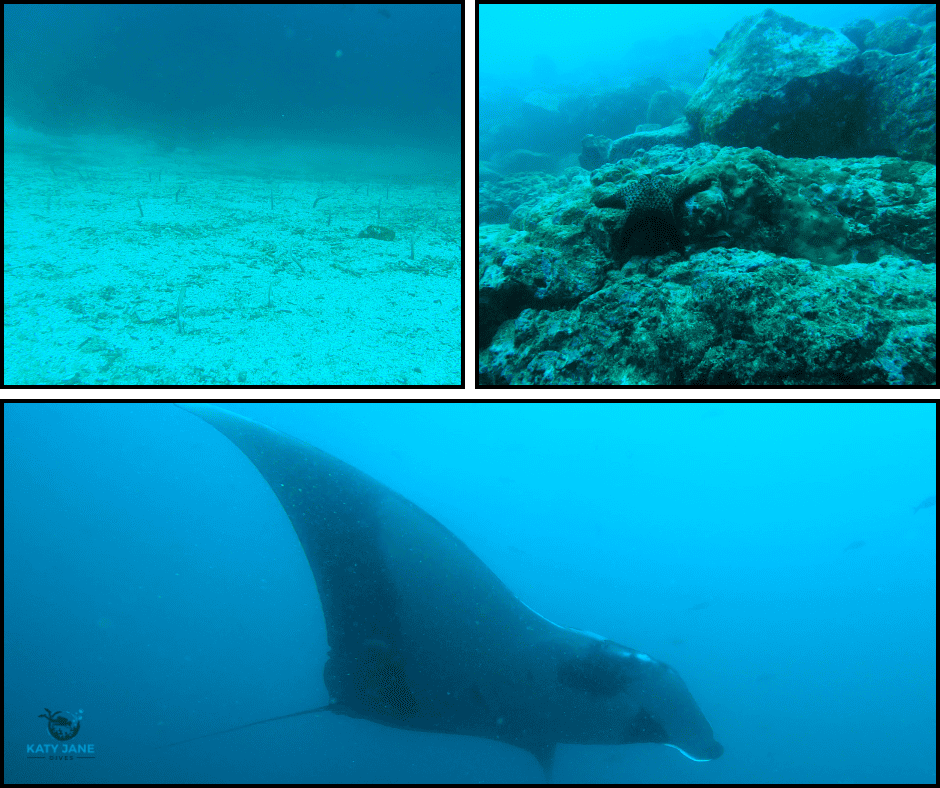
Cape Marshall, on the North Eastern Coast of Isabela, is characterised by a steep, near-vertical wall of volcanic rock that plunges into the depths of the ocean.
Divers at Cape Marshall are treated to encounters with a diverse array of marine life, including the majestic manta rays, which have earned the site the nickname “City of the Mantas.” The presence of these giant mantas is most notable from June to October, when the waters are rich in plankton, their main source of food.
My dives at Cape Marshall in February offered an extraordinary spectacle. During this time, a large number of mantas congregated close to the wall, taking advantage of the plankton-rich waters and using the area as a cleaning station amidst strong current surges. As they hovered overhead, their gigantic silhouettes became mesmerising shadows against the green, nutrient-dense backdrop.
The experience was further enriched by the sight of the sandy area of garden eels, swaying rhythmically with the currents, and a significant school of mobula rays gliding through the water with graceful ease.
The site is recommended for advanced divers due to its challenging conditions, including strong currents and a requirement for good buoyancy control. With depths ranging from 10 to 35 meters (33 to 98 feet), divers must be prepared for the site’s dynamic environment.
The marine biodiversity here is impressive, featuring not only manta rays but also hammerhead sharks, sunfish (Mola mola), and the endemic Galapagos black-striped salema, among other species. Sea turtles and playful sea lions add to the vibrant life that thrives along the volcanic wall.
Diving at Cape Marshall is a truly advanced endeavour, requiring divers to have a minimum of 30 logged dives and experience handling currents and wall dives. The conditions here can be demanding, visibility ranging from 3 to 10 meters (10 to 33 feet), and water temperatures between 17°C and 23°C (63°F and 73°F), depending on the season.
Camaño Islet
- Location: Near the bustling town of Puerto Ayora on Santa Cruz Island
- Perfect For: Advanced Open Water Diver
- Likely to See: Array of fish, sea lions and invertebrates. Also, sea lion and sea turtles
- Temperature: 18°C (64°F) to 26°C (79°F)
- Visibility: 10 and 20 meters (33 to 66 feet)
- Depth: 5 to 12 meters (16 to 39 feet)
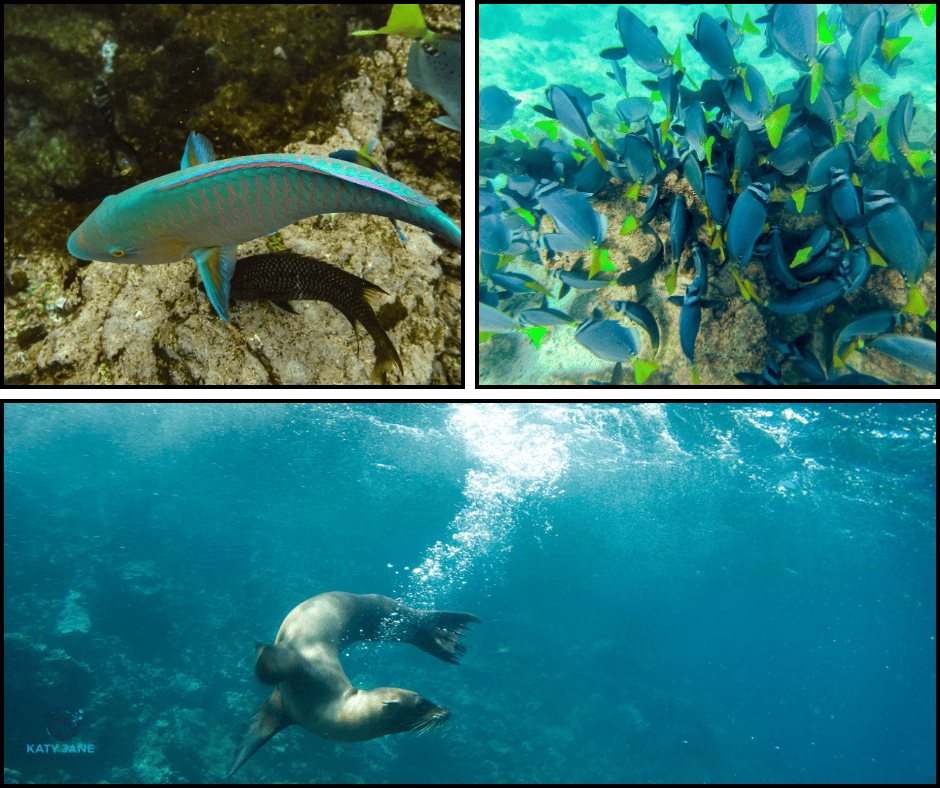
Caamaño Islet, a small, accessible spot near the bustling town of Puerto Ayora on Santa Cruz Island, serves as an ideal gateway for both divers and snorkelers to the underwater wonders of the Galapagos.
This site is particularly noted for its shallow waters, making it a fantastic location for beginners or those preferring to snorkel.
The average depth around Caamaño Islet ranges from 5 to 12 meters (16 to 39 feet), with clear visibility typically between 10 and 20 meters (33 to 66 feet), depending on the season and weather conditions. The water temperature varies similarly to other sites in the Galapagos, swinging from 18°C (64°F) to 26°C (79°F) throughout the year.
What makes Caamaño Islet stand out is its convenience and the abundance of marine life in such easily accessible waters. Located just a short boat ride from Puerto Ayora, it offers an effortless opportunity for visitors to immerse themselves in the Galapagos marine environment without committing to a full dive or long excursion.
The site is teeming with a colorful array of fish, sea lions, and invertebrates. It’s not uncommon for snorkelers to find themselves swimming alongside playful sea lion pups or observing the meticulous movements of sea turtles. While it may not boast the large pelagic species found at more remote dive sites, Caamaño Islet provides a rich, intimate encounter with the archipelago’s marine biodiversity, perfect for a day trip or those new to the underwater world.
The Landslide/El Derrumbe
- Location: On the remote Wolf Island in the Galapagos Archipelago
- Perfect For: Advanced Open Water Diver
- Likely to See: Hammerhead sharks, reef fish, large pelagic fish, manta rays and sea turtles. Also rocky outcrops, sandy patches and coral formations.
- Temperature: 21°C to 25°C (70°F to 77°F)
- Visibility: 20 meters (65 feet) or more
- Depth: 30 meters (100 feet)
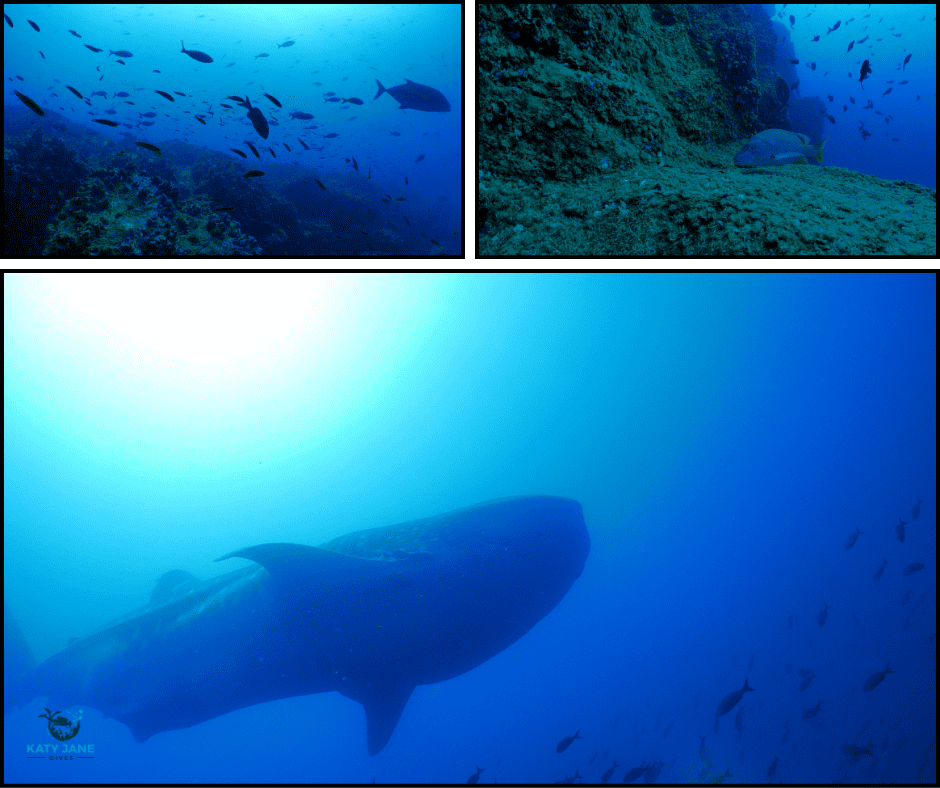
Landslide (El Derrumbe) at Wolf Island is a dive site renowned for its dramatic underwater topography and abundant marine life, making it a must-visit location for advanced divers exploring the Galapagos Islands.
This site features steep slopes and a varied seascape that drops off into the deep blue, providing an exhilarating backdrop for two memorable dives I experienced here. The depth at Landslide ranges significantly, offering both intermediate and challenging depths that can extend beyond 30 meters (100 feet), with visibility often clear up to 20 meters (65 feet) or more, depending on the current and weather conditions. Water temperatures here can vary, typically ranging from 21°C to 25°C (70°F to 77°F), making it comfortable for diving with a standard wetsuit.
During my dives at Landslide, I was first introduced to the stunning beauty hidden beneath the coastline of Wolf Island. The site is a hotspot for diverse marine life; schools of hammerhead sharks are often the stars of the show, gliding gracefully in the nutrient-rich currents. In addition to these majestic predators, the area is teeming with colorful reef fish, large pelagic fish, and occasional sightings of manta rays and sea turtles, adding to the site’s allure.
The underwater terrain at Landslide is as diverse as its inhabitants, featuring a mix of rocky outcrops, sandy patches, and coral formations. This variety creates a dynamic environment for exploration and encounters with the unique species that inhabit the Galapagos waters. The strong currents that characterise this site not only bring in a rich diversity of marine life but also contribute to the clear waters, providing excellent visibility for divers.
The Galápagos Islands are best explored via liveaboard. Read my experience of my trip with the Galaxy Diver Liveaboard – an incredible eco-friendly, local and personalised operator.
Punta Vicente Roca
- Location: Northwestern side of Isabela Island
- Perfect For: Advanced Open Water Diver
- Likely to See: Seahorses, frogfish, nudibranchs, manta rays, sea turtles and sunfish. Also, vertical garden of marine life, coral formations, sponges and array of fish species.
- Temperature: 18°C and 24°C (64°F and 75°F)
- Visibility: 10 to 30 meters (30 to 100 feet)
- Depth: 89 to 100 ft
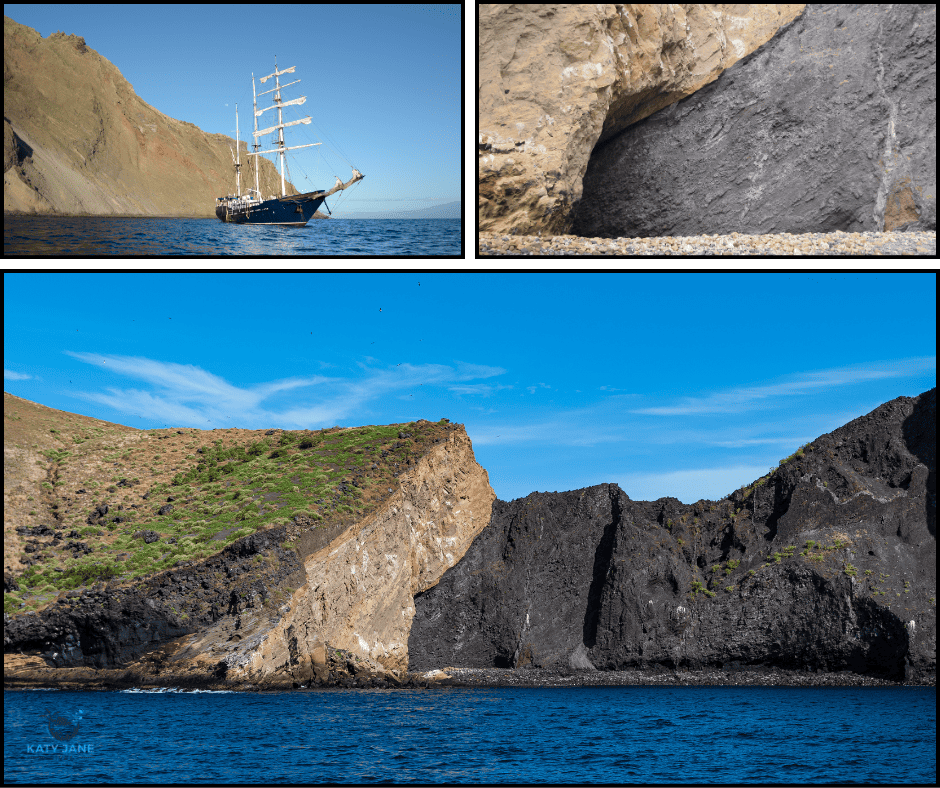
Vicente Roca Point, nestled on the northwestern side of Isabela Island, stands as a testament to the Galapagos’ underwater marvels, offering one of the archipelago’s premier wall dives.
This site is not just a haven for divers but also presents a fantastic snorkeling opportunity, appealing to a wide range of marine enthusiasts. The wall plunges into the depths, creating a stunning backdrop for the diverse marine life that thrives here.
The nutrient-rich currents flowing through Vicente Roca Point attract a spectacular array of sea creatures, including seahorses, frogfish, and a variety of nudibranchs, providing an ever-changing tapestry of color and form against the volcanic rock face.
Divers often encounter manta rays, turtles, and the occasional sunfish (Mola mola), making each dive a unique exploration. For those lucky enough to dive here, the clear waters offer visibility ranging from 10 to 30 meters (30 to 100 feet), depending on the season, with water temperatures varying between 18°C and 24°C (64°F and 75°F).
The overhanging wall itself is a geological wonder, showcasing the volcanic activity that has shaped the Galapagos Islands over millennia. As divers and snorkelers drift along the wall, they’re treated to a vertical garden of marine life, including vibrant coral formations, sponges, and a multitude of fish species.
North Seymour
- Location: North-east of Baltra Island
- Perfect For: Advanced Open Water Diver
- Likely to See: Mosaic of corals and sponges, array of fish species and sea lions.
- Temperature: 20°C to 26°C (68°F to 79°F)
- Visibility: 10 to 20 meters (30 to 60 feet)
- Depth: 52 to 59 ft (16–18 meters)
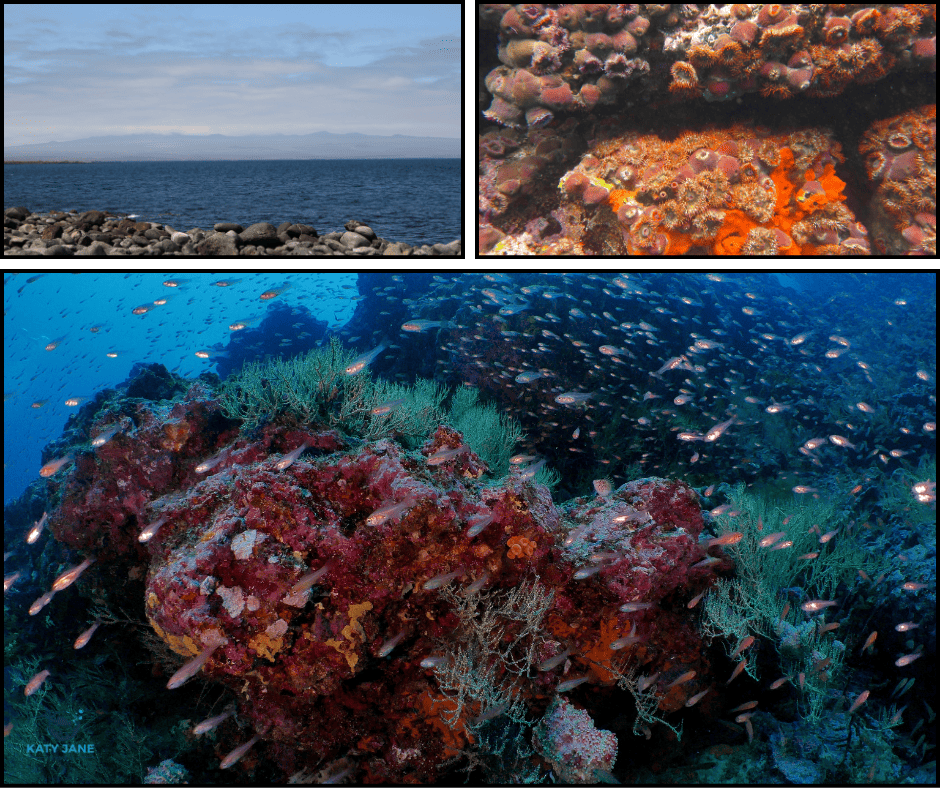
A notable site on the north-east of Baltra Island, serves as an ideal introductory dive for those embarking on their underwater adventure in this iconic archipelago.
It’s often chosen for check dives, as was the case for my very first Galapagos dive, due to its relatively calm conditions and moderate depth, making it perfect for acclimating to the local diving environment.
This site offers divers the chance to explore a vibrant underwater landscape teeming with life. Visibility at North Seymour can range from 10 to 20 meters (30 to 60 feet), with water temperatures averaging between 20°C to 26°C (68°F to 79°F), depending on the season. The seabed here is a colorful mosaic of corals and sponges, providing a home to an array of fish species and other marine life.
My dive at North Seymour was memorable not just for being my first in the Galapagos but also for my first glimpse of a playful sea lion, which are often the highlight for many divers.
These agile creatures are known for their curious nature, offering a unique experience as they twist and turn through the water, sometimes coming close to inspect their human visitors. In addition to sea lions, the site is rich in marine biodiversity, including a variety of fish and the chance to see rays gliding gracefully along the ocean floor.
North Seymour’s relatively gentle conditions and the abundance of life make it a lovely dive site that provides a gentle introduction to the Galapagos Islands‘ underwater world. It sets the stage for the more challenging dives ahead, offering a glimpse into the marine diversity that makes this destination so special for divers around the world.
Cousins Rock
- Location: Off the coast of Santiago Island
- Perfect For: Advanced Open Water Diver
- Likely to See: Rock formations, ledges and overhangs, nudibranchs, frogfish and seahorses
- Temperature: 22°C (72°F)
- Visibility: 10 to 25 meters (33 to 82 feet)
- Depth: 10 to 30 meters (33 to 100 feet)
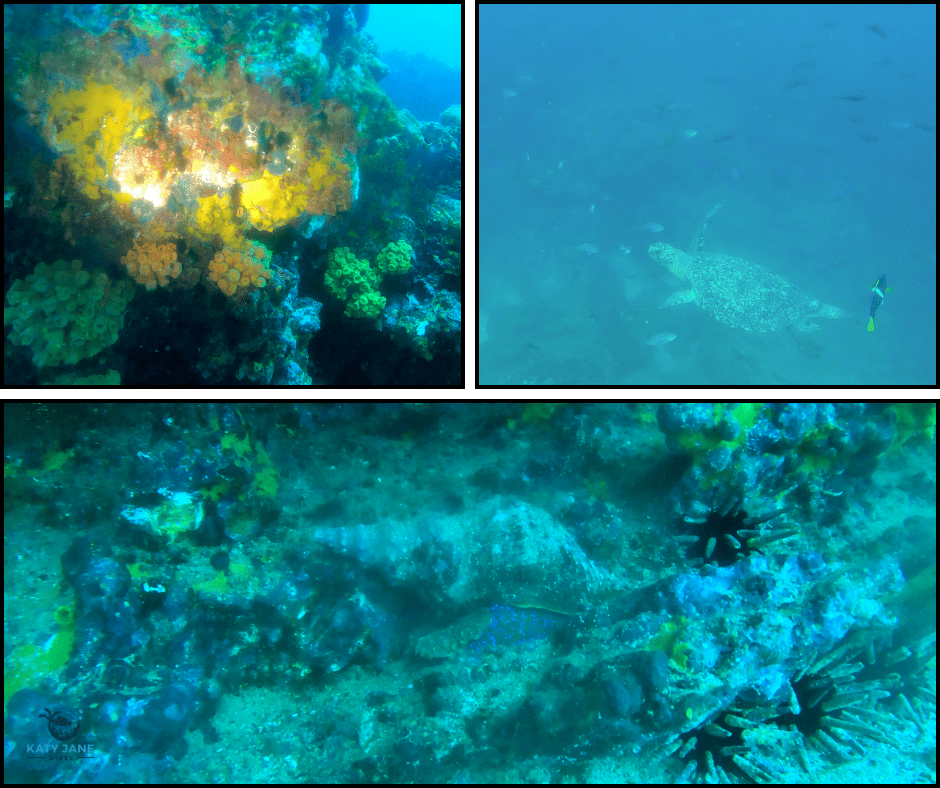
Cousins Rock is a unique and captivating dive site located off the coast of Santiago Island.
This site is well-known for its stunning topography, featuring a series of steep rock walls, ledges, and overhangs that create an underwater landscape ripe for exploration. The site’s depth ranges from 10 to 30 meters (33 to 100 feet), making it accessible to a wide range of diver experience levels, though the presence of currents means divers should be comfortable with changing conditions.
Visibility at Cousins Rock can vary but typically offers clear views ranging from 10 to 25 meters (33 to 82 feet), allowing divers to fully appreciate the vibrant marine life and intricate rock formations. The water temperature at this site can be cooler compared to other Galapagos dive locations, often dropping below 22°C (72°F), which was notably the coldest experience for my dives in the archipelago.
This drop in temperature contributes to the richness of marine biodiversity here, including a plethora of macro life such as colorful nudibranchs, frogfish, and the elusive seahorses—though they managed to hide during my visit.
Cousins Rock is celebrated for its shallow dive profile, which I found to be an enjoyable contrast at the end of my liveaboard trip. The unique geological formations, including the rock walls that drop sharply into the blue, create a mesmerising backdrop for the dive. Swimming along these formations, I was engrossed in the small nooks and crannies that house an abundance of macro life, providing a different pace and focus compared to the larger marine animals encountered at other sites around the Galapagos.
My final dives here were a memorable conclusion to the Galapagos liveaboard experience. Despite not spotting the seahorses, the thrill of exploring the unique rock formations and encountering the abundant macro life was unparalleled.
The initial shock from the cold water as we backrolled off the panga was a vivid reminder of the diverse and challenging environments the Galapagos offers to divers.
Roca Redonda
- Location: Off the northwestern coast of Isabela Island
- Perfect For: Advanced Open Water Diver
- Likely to See: Volcanic rock formations, underwater fumaroles, hammerhead sharks, Galapagos sharks, manta rays and whale sharks.
- Temperature: 18°C to 25°C (64°F to 77°F)
- Visibility: 15 to 30 meters (50 to 100 feet)
- Depth: 30 meters (100 feet)
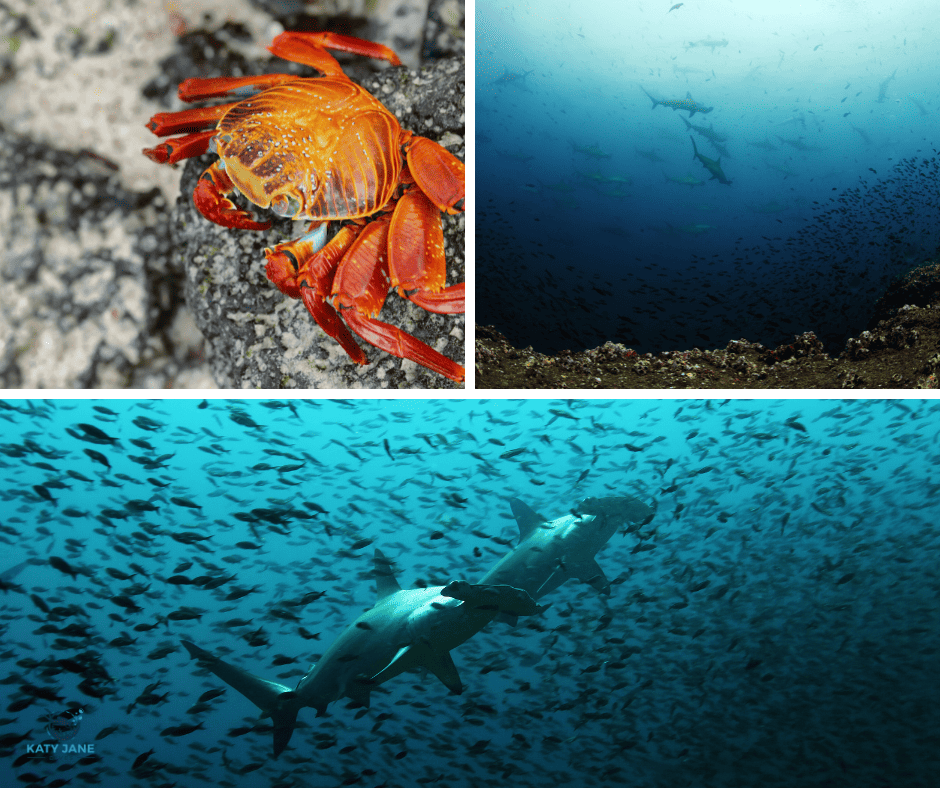
Roca Redonda is an isolated, submerged volcano peeking above the surface of the Pacific Ocean, located off the northwestern coast of Isabela Island.
This dive site is renowned among advanced divers for its unique underwater landscape, challenging conditions, and the chance to witness some of the archipelago’s most intriguing marine phenomena.
The dive depths at Roca Redonda can range significantly, with some areas dropping well below 30 meters (100 feet). The visibility here is generally good, often between 15 to 30 meters (50 to 100 feet), offering clear views of the volcanic rock formations and the abundant marine life that calls this area home. Water temperatures hover around 18°C to 25°C (64°F to 77°F), depending on the time of year and the currents.
Roca Redonda’s unique feature is its underwater fumaroles, where gases escape from the ocean floor, creating a surreal underwater spectacle reminiscent of a landscape more commonly associated with outer space. Divers can see bubbles rising from the depths, which is a rare sight and a reminder of the volcanic activity that formed these islands.
The marine life around Roca Redonda is as diverse as it is abundant, with large schools of hammerhead sharks often being the main attraction. Galapagos sharks, manta rays, and even occasional whale sharks are drawn to the nutrient-rich waters, fueled by the upwellings around the submerged volcano.
Due to its exposed position and the potential for strong currents, Roca Redonda is recommended for experienced divers who are comfortable in open water and can navigate the occasionally challenging conditions.
Roca Redonda stands out not just for its underwater topography and resident marine life but also for the opportunity it presents to dive among the visible signs of the Earth’s volcanic activity.
Bartholomew Point
- Location: near Bartholomew (Bartolome) Island
- Perfect For: Advanced Open Water Diver
- Likely to See: Sea lions, sea turtles, marine iguanas and native Galapagos penguins. Also, whitetip reef sharks, barracudas, stingrays, modula rays and variety of reef fish
- Temperature: 69°-84°F / 21°-30°C
- Visibility: 18 m. (60 ft.)
- Depth: 40 to 80 feet (or 12-27 meters)
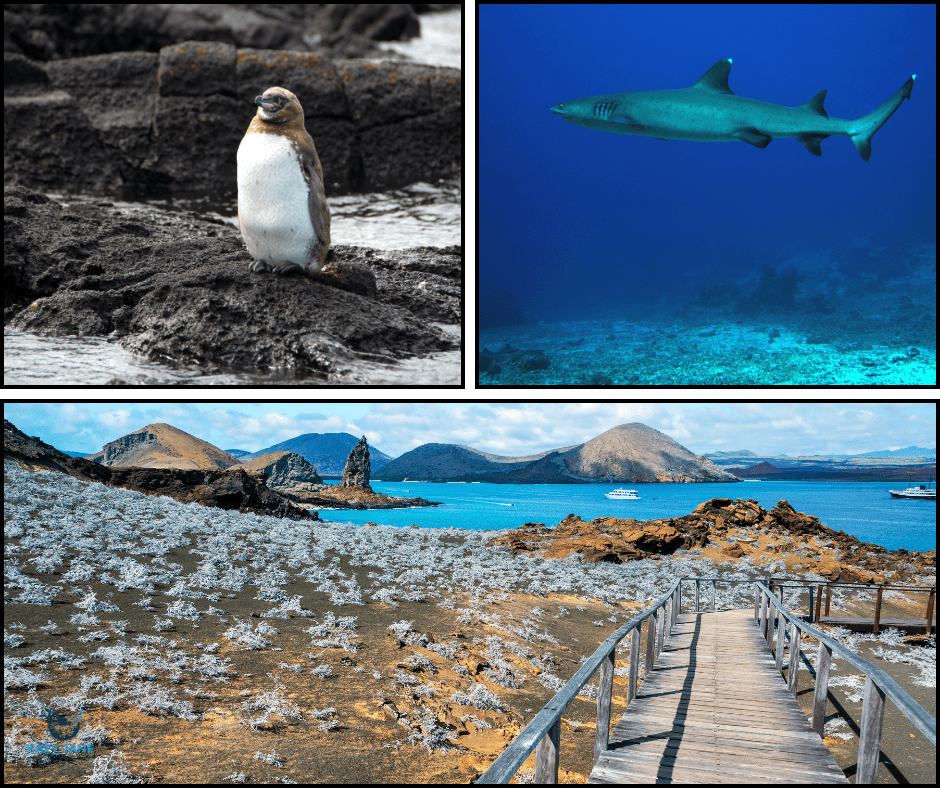
Bartholomew Point is one of the Galápagos Islands’ most iconic and biodiverse dive sites, offering a unique underwater experience for both novice and experienced divers.
Situated near Bartholomew (Bartolome) Island, the dive site is characterised by stunning lava and rock formations that create a rich habitat for an array of marine life. Divers at Bartholomew Point can enjoy encounters with friendly sea lions, graceful sea turtles, marine iguanas, and the native Galápagos penguins, which are the most northernly occurring penguin species.
The dive site boasts moderate currents, making it accessible and enjoyable for divers with various levels of experience. The famous pinnacle rock near Bartholomew Point is not only a striking natural monument but also provides spectacular photographic opportunities both above and below the water.
The underwater world here is vibrant and teeming with life, including whitetip reef sharks, barracudas, stingrays, modula rays, and a colorful variety of reef fish.
Bartholomew Point is a testament to the Galápagos Islands’ volcanic origin, offering divers the chance to explore the unique geological formations that are as educational as they are beautiful. The diversity of marine life here is a direct result of the Galápagos Islands’ isolation and the varied habitats created by volcanic activity.
Whether you’re hovering over the sandy sea floor, exploring the rocky reefs, or photographing the peculiar behaviours of endemic species, Bartholomew Point promises an unforgettable diving adventure in one of the most pristine and diverse ecosystems on the planet.
Kicker Rock
- Location: Found in the heart of the Galapagos National Park
- Perfect For: Advanced Open Water Diver
- Likely to See: Salema fishes, hammerhead sharks, Galapagos sharks, turtles, eagle rays, golden rays and sea lions
- Temperature: 81°F / 27.2°C
- Visibility: 5-15 meters (16 - 49 ft)
- Depth: 20 meters (60 feet) to around 13-15 meters (40-50 feet)
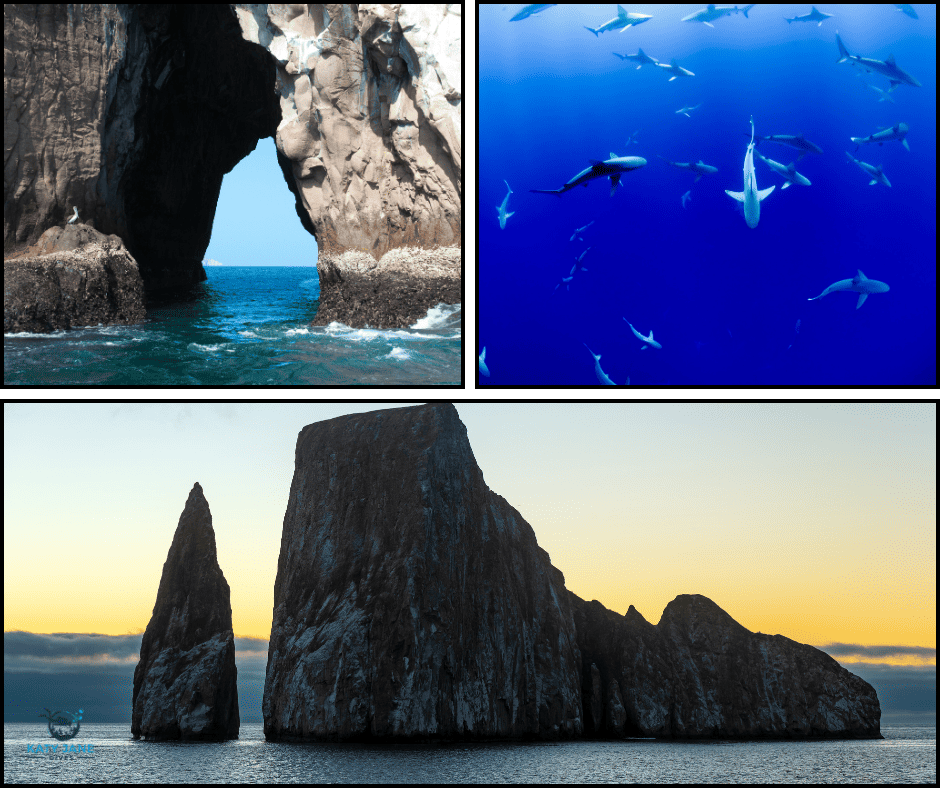
Kicker Rock, also known as León Dormido, is a breathtaking dive site renowned for its unique geological formation—a sheer-walled tuff cone that has been split in half, creating a channel between the two towering rock structures.
This site has garnered fame not only for its dramatic underwater topography but also for the abundance of marine life it attracts, making it a must-visit destination for divers and snorkelers alike.
The dive site is especially celebrated for offering encounters with a variety of marine species, including schools of Salema fishes, Hammerhead sharks, Galápagos sharks, turtles, eagle rays, golden rays, and playful sea lions.
The vertical walls of the rock plunge 60 meters (200 feet) straight down, presenting a thrilling experience for divers with good buoyancy control. The currents at Kicker Rock are generally mild to moderate, making the dives enjoyable yet requiring a certain level of skill and comfort in the water. The dive typically includes navigating through the channel that slices through the rock, surrounded by the immense walls, where the depth gradually shallows from 20 meters (60 feet) to around 13-15 meters (40-50 feet), offering a diverse range of environments within a single dive.
For those who prefer snorkeling or are accompanying divers, Kicker Rock also provides an exceptional snorkeling experience, with clear waters and abundant marine life visible even from the surface.
While I personally did not have the chance to dive at Kicker Rock, the site’s reputation and the vivid accounts I’ve heard from those who have experienced its underwater marvels firsthand leave no doubt about its allure. A simple search on social media reveals countless images and videos showcasing the close encounters divers and snorkelers can have with Hammerhead sharks, highlighting the site’s significance as a premier destination for marine life enthusiasts.
Daphne Major
- Location: Off the coast of Santa Cruz Island
- Perfect For: Advanced Open Water Diver
- Likely to See: Seabirds, sea lions, manta rays, species of sharks also seahorses, and nudibranchs
- Temperature: 18°C (64°F) in the cooler season to 25°C (77°F)
- Visibility: 10 to 30 meters (30 to 100 feet)
- Depth: 88 feet (27 meters)
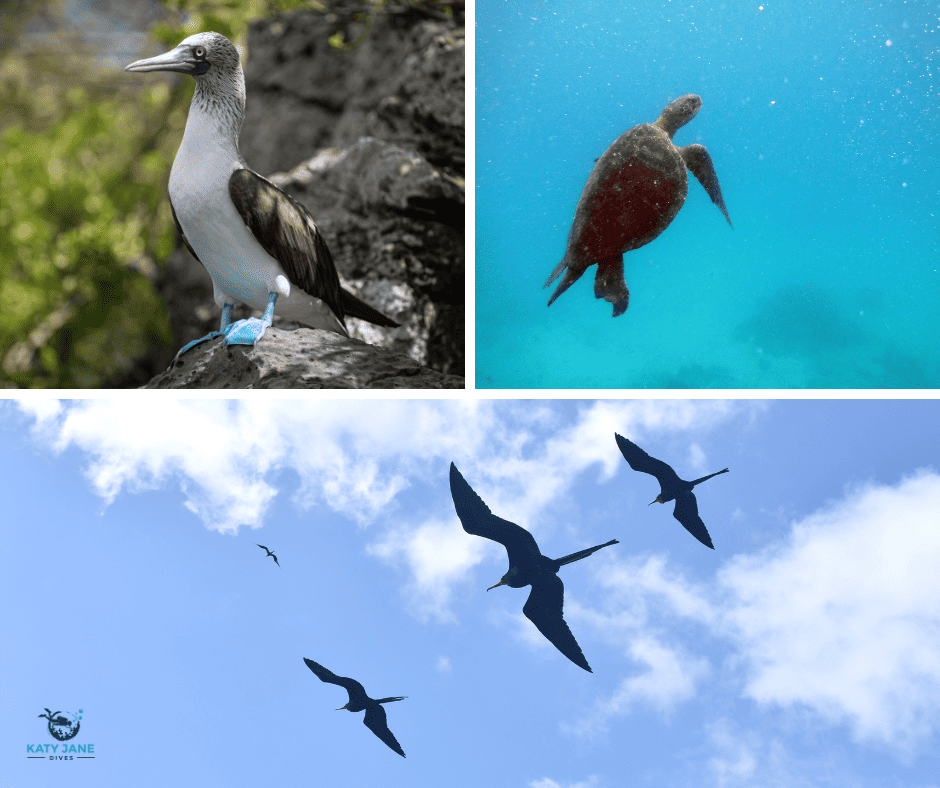
Daphne Major, off the coast of Santa Cruz Island, is acclaimed for the turtle and shark sightings, allowing for some dramatic underwater photography opportunities.
It offers similar conditions to other sites around Santa Cruz; moderate to strong currents, visibility ranging from 10 to 30 meters (30 to 100 feet), and water temperatures varying between 18°C (64°F) in the cooler season to 25°C (77°F) during warmer months.
The island itself, characterised by steep cliffs and rocky shores, is a haven for a plethora of seabirds, including Nazca and Blue-footed Boobies, Frigate Birds, and others, making it a unique spot where divers can enjoy both marine and terrestrial biodiversity.
Underwater, Daphne Major offers divers the chance to explore a world teeming with life along its submerged walls and rocky reefs. The nutrient-rich waters of the Galapagos bring forth an impressive array of marine life.
Divers at Daphne Major might encounter sea lions playful in their natural habitat, graceful mantas, and various species of sharks, including the Galapagos shark and occasionally hammerheads, swimming in the blue.
The site is also a paradise for macro enthusiasts, with a chance to spot seahorses, nudibranchs, and other small critters among the rocks and crevices.
While Daphne Major may not have the same level of fame as other Galapagos dive sites, its relatively shallow depths make it an excellent location for both beginner and experienced divers. The clear waters and the abundance of marine life provide an unforgettable diving experience, where every dive is a discovery of new wonders.
For those intrigued by the interaction between marine and bird life, Daphne Major offers a unique spectacle. Divers and snorkelers can enjoy the underwater world and then surface to the sounds of seabirds, creating a seamless nature experience that encapsulates the essence of the Galapagos.
Whale Rock
- Location: 30 min from Baquerizo Moreno port in San Cristobal
- Perfect For: Advanced Open Water Diver
- Likely to See: hammerhead sharks, Galapagos sharks, whale sharks, sea lions and breathtaking underwater topography
- Temperature: 55 to 82 degrees Fahrenheit (12 to 28 degrees Celsius)
- Visibility: 10 meters and it can get to 20-25 meters
- Depth: 16m (55ft) to 90ft (25m)
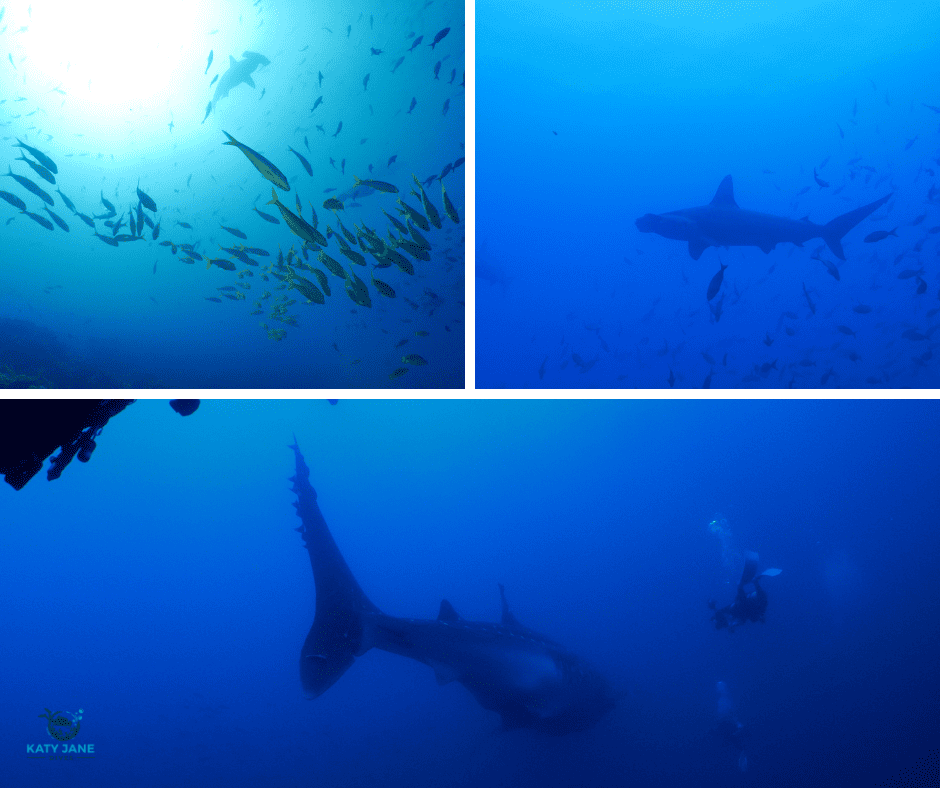
Whale Rock, also known as Roca Ballena, is a distinguished dive site celebrated for its extraordinary marine biodiversity and unique geological formations.
The dive at Whale Rock has the possibility of encountering a wide variety of marine life, including but not limited to schools of hammerhead sharks, Galapagos sharks, whale sharks, especially from June through November during the whale shark season, and manta rays during the manta season from December to May.
The visibility and water temperatures at the site can vary significantly with the season, with water temperatures ranging from 55 to 82 degrees Fahrenheit (12 to 28 degrees Celsius).
Whale Rock is known for its challenging dive conditions, including strong currents and surges, which require divers to be experienced and well-prepared with appropriate safety equipment. These conditions are part of what makes diving here so rewarding, as they contribute to the high nutrient levels in the water that attract such a wide array of marine life.
These dive sites offer a mesmerising variety of marine wildlife, from elusive sharks to playful sea lions, on the backdrop of the Galapagos’ unique underwater topographies.
Whether you’re a marine conservationist, pro-photographer, or a diving enthusiast, you’re sure to discover a whole new world beneath the ocean surface.
Besides the incredible diving, the Galapagos and Ecuador are extremely welcoming places to travel to.
Where is the Best Diving in the Galapagos Islands?
When it comes to where the best diving in the Galapagos Islands is, there are a multitude of options. Each location offers a distinctive diving experience that varies depending on the marine species present, underwater topography, and ocean surface conditions.
Among these, the northwestern corner of the Galapagos, particularly Wolf and Darwin Islands, holds some of the top dive sites. Surrounded by powerful currents and chilled water temperatures, these locations are more suited to experienced divers. Likely sightings here include the often sought-after hammerhead sharks, silky sharks, whale sharks, and with some luck, manta rays and playful dolphins. You will also get a chance to marvel at the exceptional rock arch/pillar landmark at Darwin Island.
In the central region of the Galapagos, there are exciting options to consider. Floreana, Gordon Rocks, and North Seymour, offer intermediate divers a chance to get up close and personal with sea lions, sea turtles, and an abundant array of fish species.
Notably, Gordon Rocks, just off the coast of Santa Cruz Island, is considered a hot spot for hammerhead and Galapagos sharks. Don’t forget to keep an eye out for the lesser-spotted batfish here too!
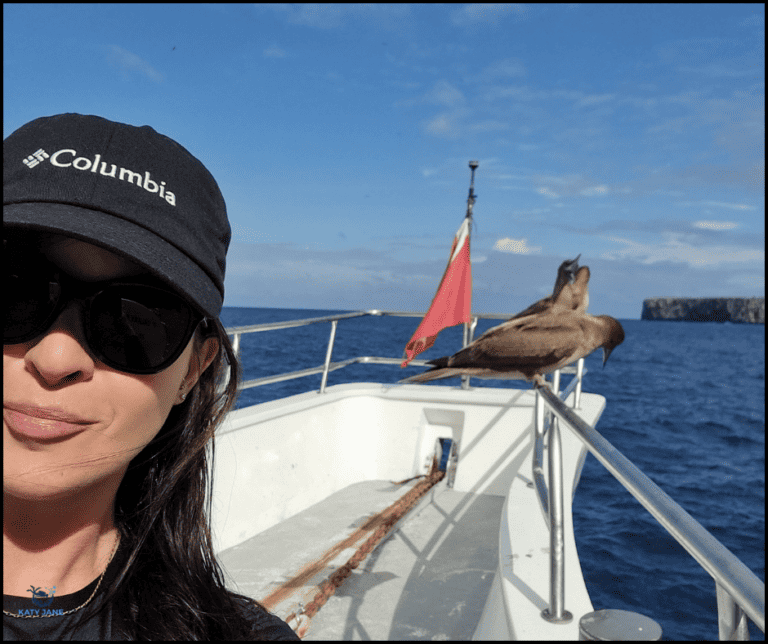
Venturing further to the southern and eastern parts of this archipelago, divers can explore sheer drop-offs populated by rays and groupers, and discover the vibrant small-scale marine life that resides there, including seahorses and numerous invertebrates.
The Galapagos Islands’ diving sites are concentrated around the key islands that comprise this unique archipelago. Distinct locations like San Cristobal and Santa Cruz serve as launching points for a considerable 16 out of the 24 top dive sites. A unique offering is the opportunity to embark on a night dive at Academy Bay, enriching the plethora of experiences.
Galapagos Diving Information
As frequently sought-after scuba diving spots, the Galapagos Islands often captivate the most experienced and well-travelled divers with their extraordinary marine life encounters and captivating dive sites.
Best Time to Scuba Dive the Galapagos
The Galapagos offers a year-round diving experience that caters to different specific interests. If the goal is to see manta rays and hammerhead sharks in their most active states, the general advice is to book a dive trip within the months of May and November.
However, if divers want to tick off a wide array of marine animals from their bucket list, be it manta rays, hammerheads, or the elusive whale sharks, the sweet spot lands in May. This data bears in mind sightings, weather, temperature, and ocean surface conditions – projected for divers to have an astounding experience.
Galapagos Diving Conditions
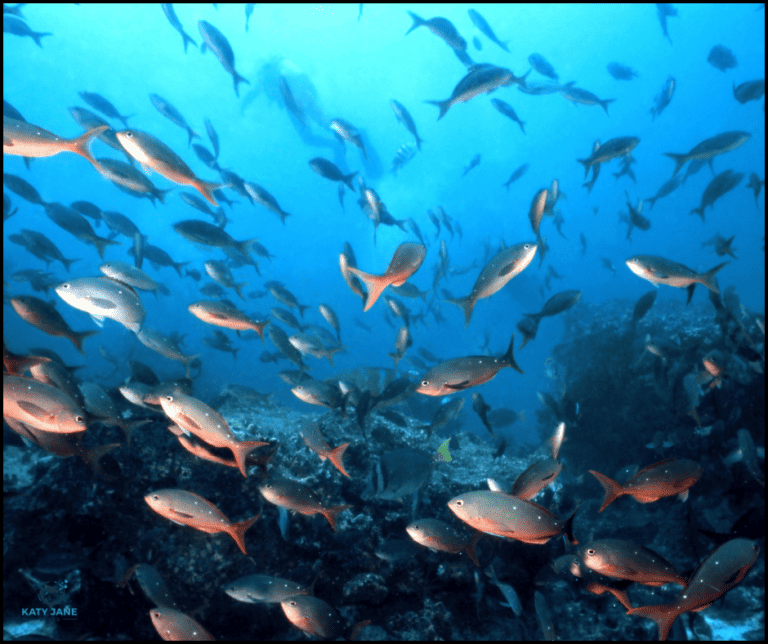
The Galapagos is remarkable for its diverse diving conditions, suitable for experiencing large marine life native to both warm and cold water climates.
Photo enthusiasts will find the area a paradise for both wide-angle and macro underwater photography opportunities due to its strikingly diverse sea life.
Average diving depths typically range between 21-35 meters, though beginners may find areas where depths are around 9-20 meters.
Be mindful of stronger currents and a generally rougher sea between June and November, which can present more challenging conditions for inexperienced divers.
Galapagos Diving Difficulty
For novices looking for underwater adventure, the Galapagos provides sites that can accommodate beginners.
Generally, the months of December to June offer calmer and warmer waters, making it more suitable for those with limited diving experience.
Intermediate diving spots like Gordon Rocks and the Camaño Islet are perfect for those divers ready to take on a bit more adventure.
However, the primary allure of the region lies in its appeal to advanced divers. Notably rugged underwater surfaces, cooler waters, and stronger currents set the stage for exhilarating encounters with the diverse marine species. Sites like Darwin Island offer a unique setting for divers to experience the magnificent marine biodiversity.
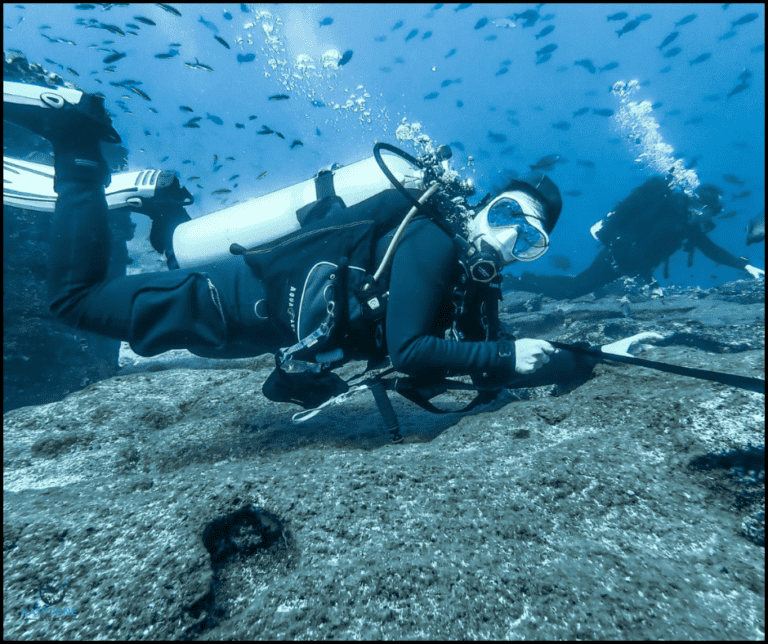
Most liveaboard operators in the Galapagos have a policy of not accepting bookings from divers with fewer than 50 logged dives and most require at least an Advanced Open Water Diver qualification too. This requirement is set with good reason, considering the challenging conditions that can include strong currents, cooler water temperatures, and the advanced diving techniques, such as negative entries, often required.
For divers aspiring to embark on a Galapagos liveaboard adventure, it is wise to gain experience in a variety of diving conditions. Accumulating at least 50 logged dives, including those in different environments and conditions, will not only meet the booking criteria but also ensure divers are well-prepared to safely enjoy and make the most of their Galapagos experience.
The currents in the Galapagos can indeed present a formidable challenge, particularly for those unaccustomed to drift diving.
During my trip, most dives were drift dives, where we would execute a negative entry from the panga and allow the current to carry us along the wall or through the dive site. This method of diving requires a good deal of trust in the current and in our guides, who were adept at reading the water’s movement. They would sometimes instruct us to hook into a rock with our reef hooks if the current intensified suddenly. Remarkably, it was during these moments of increased current that the ocean’s giants would make their grand appearances—mantas gracefully gliding in for a bubble massage or a breathtaking school of hammerheads looming out of the blue.
Our safety stops were conducted away from the rocks, in the open blue, adding an element of serene suspense to the end of each dive. I vividly recall surfacing at the end of a dive at Darwins Pillars and being astonished at the distance we had drifted from the initial drop point during our safety stop.
The realisation of how far we had moved, simply floating in the current, was astounding. For a clearer picture of this remarkable drift, have a look at the map below, where my Garmin Mk2s logged my surface GPS track—a tangible reminder of the powerful forces at play in the Galapagos waters and the unforgettable experiences they facilitate.
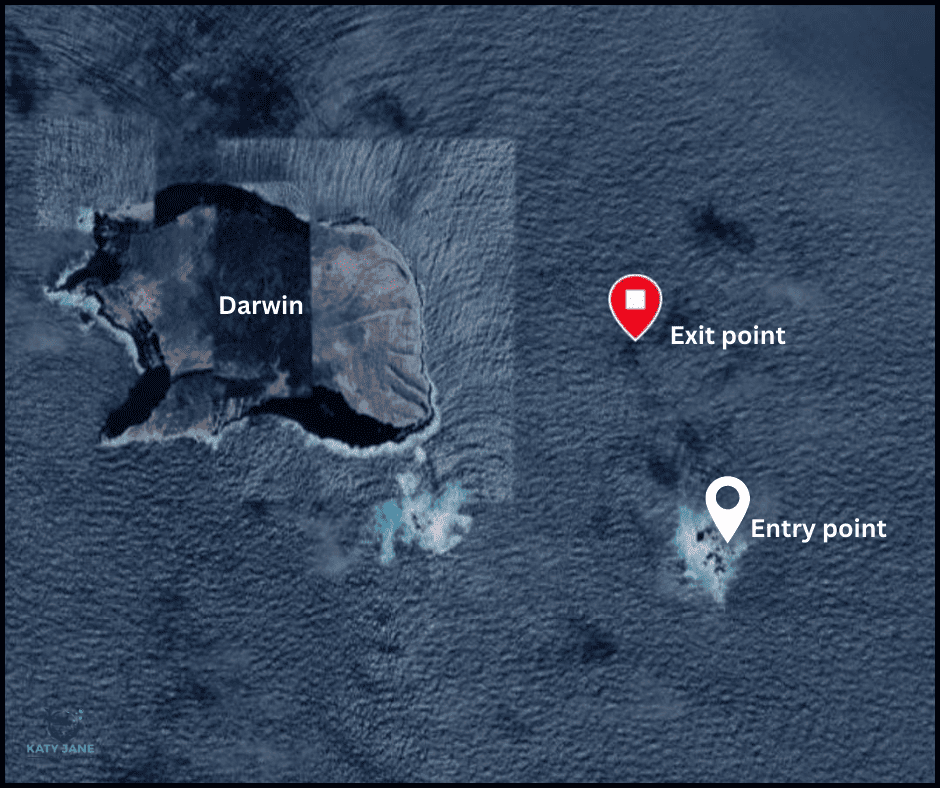
Whether it’s the encounter with Galapagos sharks, the sight of playful sea lions, the graceful swim of manta rays, or the distinctive beauty of hammerhead sharks, the Galapagos offers a truly unforgettable diving experience. However, it’s advisable for divers always to consider their skill level, the diving conditions, and the time of year to fully revel in the Pacific Ocean’s underwater utopia.
How to Get to the Galapagos
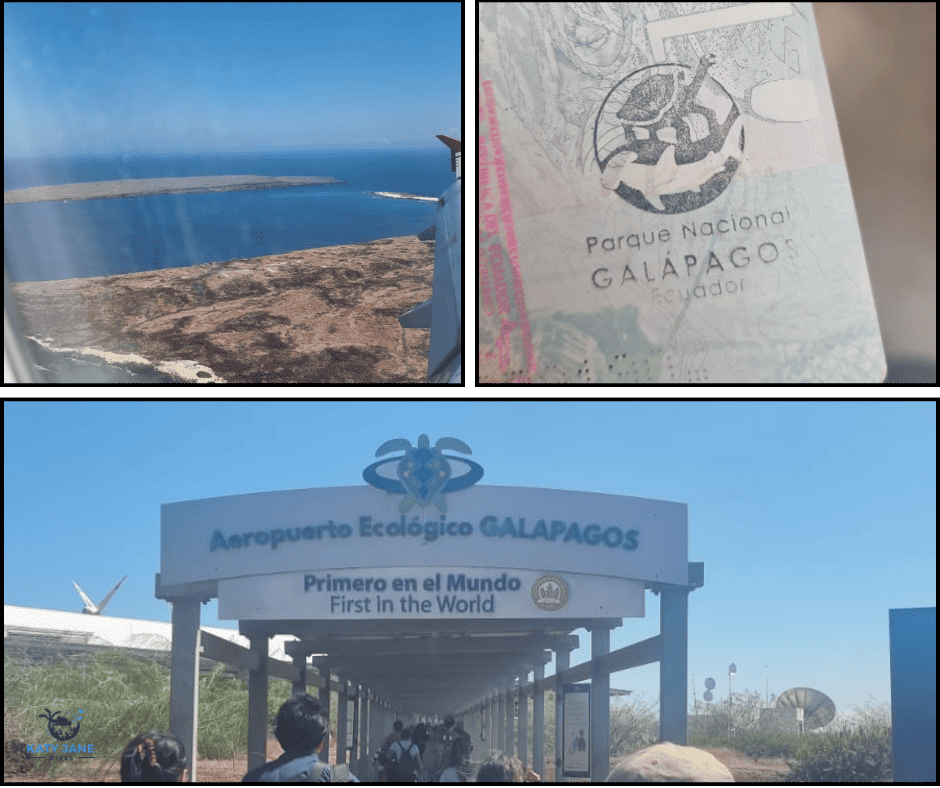
Getting to the picturesque Galapagos, famously known as the volcanic islands in the Pacific Ocean, is a journey worth taking. The island group, made popular by Charles Darwin and the protected National Park, is about 500 nautical miles (925 km) off the coast of Ecuador. Its location on the equator makes the islands a biodiversity hotspot, featuring unique marine life and brilliant scuba diving opportunities.
To access these diverse ecosystems, travellers book flights to Ecuador, South America. Ecuador serves as the only gateway to the Galapagos, with flights departing from two airports – Quito and Guayaquil.
Two airports, located on the islands of Baltra and San Cristóbal, welcome visitors ready to plunge into the startling turquoise waters, and inter-island transfers are commonly managed by small planes or boat services.
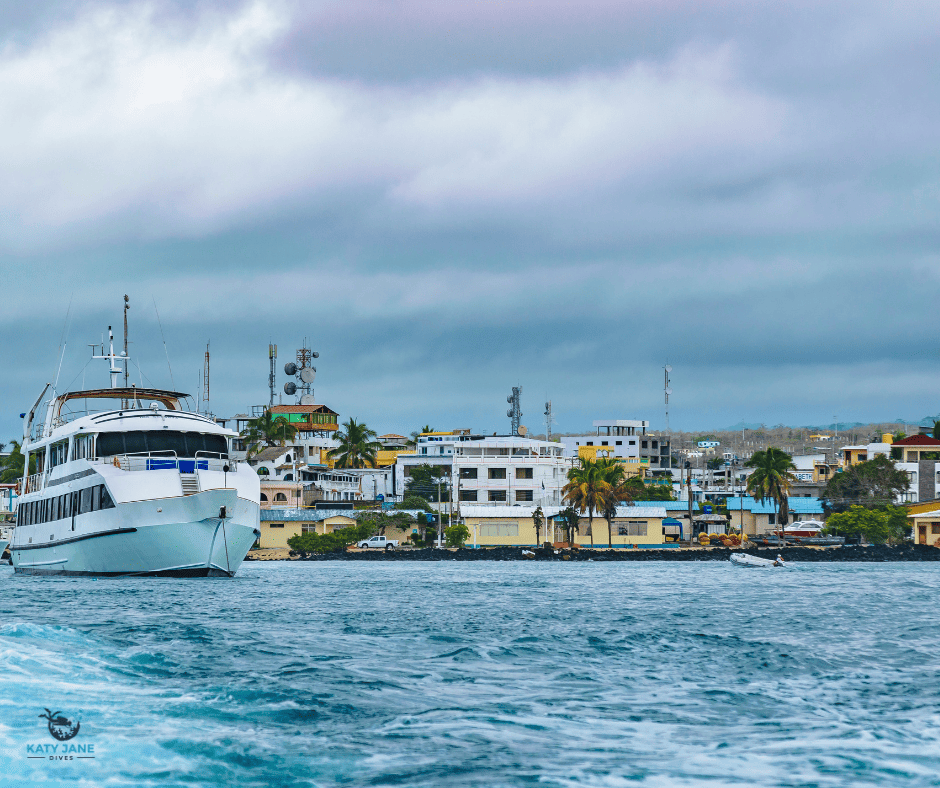
Once there, to ensure an efficient onboarding experience, payment for entrance to the National Park is suggested in cash—an affordable $100 for foreigners. Transfers to Puerto Ayora or other prominent locations are feasible by airport bus or taxi.
Just note, as you’re busy packing your gear for the big dive, the Galapagos are a UNESCO World Heritage Site, bringing with it a set of guidelines and protocols designed to preserve and protect its fragile ecosystem. Adhering to these rules ensures the continued survival of endemic land animals, the flourish of the coral reefs, and the protection of the various marine species that contribute to making the Galapagos a world-renowned diving destination.
Efficient planning can hence ensure a smoother encounter with the exotic Galapagos, both above and beneath the water.
Entrance fee to the Galapagos National Park will be rising to $200 for international visitors in August 2024.
This is the first raise since 1998 and will help raise funds for conservation and the local community.
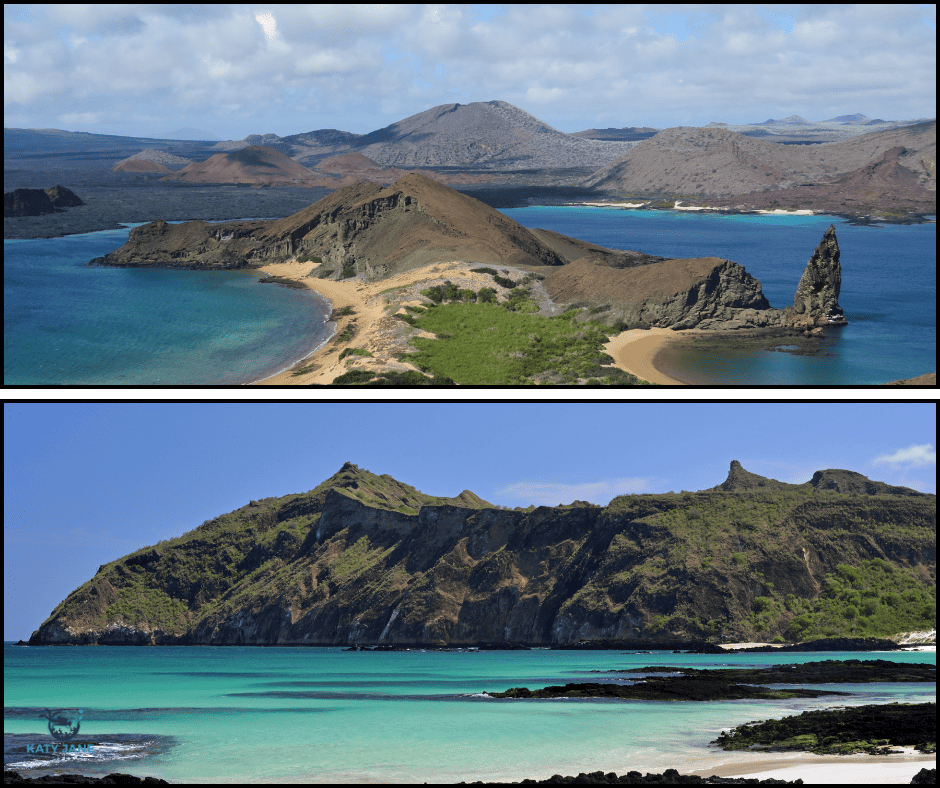
Once you’re in Galapagos, your diving journey may begin in earnest. Liveaboards are a prevalent choice for divers keen on hitting all prime spots in a single visit. Especially for remote islands like Wolf and Darwin Island, considered amongst the best dive sites in Galapagos, a liveaboard is the only feasible way to explore them. Typical liveaboard trips last around 7 nights and often include a land tour option alongside the magnificent underwater adventures.
But it’s not just about the dive sites alone – it’s about the extraordinary marine life you’ll encounter. Think: hammerhead sharks, manta rays, silky sharks, and so much more. I even had a glimpse of a tiger shark here at Darwin! The Galapagos waters are filled to the brim with fascinating marine biodiversity, an absolute treat for underwater photography aficionados.
Boost your experience by engaging with local dive centres, reputed for their in-depth knowledge about the area, promising an unforgettable dive. These centres provide a variety of scuba diving courses and daily dive trips, perfect for both beginner and seasoned divers.
Snorkelling in the Galapagos
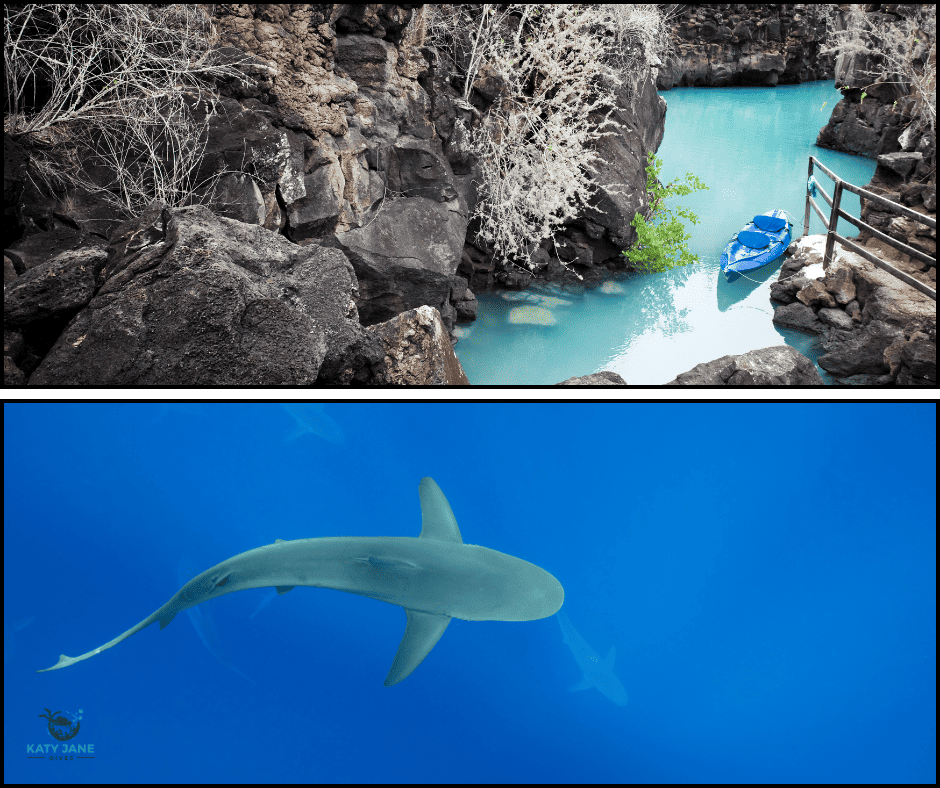
When considering a journey under the waves in the Galapagos, it’s important not to overlook the wonders of snorkelling. Diving might be the star attraction in these waters, but snorkelling provides a unique perspective on the diverse marine life inhabiting the Pacific Ocean.
Take Devil’s Crown, for instance. Dubbed as a favourite among professional divers and enthusiastic visitors, it doesn’t just cater to scuba diving fanatics. Galapagos snorkelling tours here unfold at the centre of the crown, a thriving undersea spectacle populated by penguins, sea lions, and a variety of sharks – including reef sharks, white-tip, and, of course, hammerhead sharks.
The vegetation at Devil’s Crown – a blend of mangrove and coral – is a haven for small fish and a critical combatant against climate change. This underwater ecosystem’s significance makes snorkelling here an ecologically mindful activity, a chance to witness firsthand the vibrant life that drives the Earth’s health.
Exploring the Galapagos underwater doesn’t stop with the Devil’s Crown. Imagine a 15 km long extinct volcanic caldera waiting to be discovered at Darwin Bay on Genovesa Island. In these deep waters, snorkelers can experience swimming alongside Galapagos manta rays, eagle rays, and, once again, hammerhead sharks.
Another site that deserves mention is Kicker Rock, situated northwest of Puerto Baquerizo Moreno. This rock formation, around 149 m high, rewards visitors with sightings of sharks. Here, snorkelers can follow their guide to an unforgettable undersea journey, shadowed by pelicans, Nazca boobies, and lava gulls.
Visitors can enjoy a multitude of fish species in Galapagos north, the islands Darwin and Wolf, particularly famous for an astounding variety of sharks – white and black-tip sharks, hammerhead sharks, and reef sharks. It’s an enchanting site promoting a refuge from poaching and fishing, captivating for any snorkeler driven to experience pristine marine ecosystems.
Being passionate about scuba diving is great, but it’s worth noting that snorkelling in Galapagos can provide an equally enthralling encounter with marine life. For those looking to gain more experience underwater, Galapagos is undoubtedly a prime contender for the top spot.
Wildlife and Marine Conservation in the Galapagos
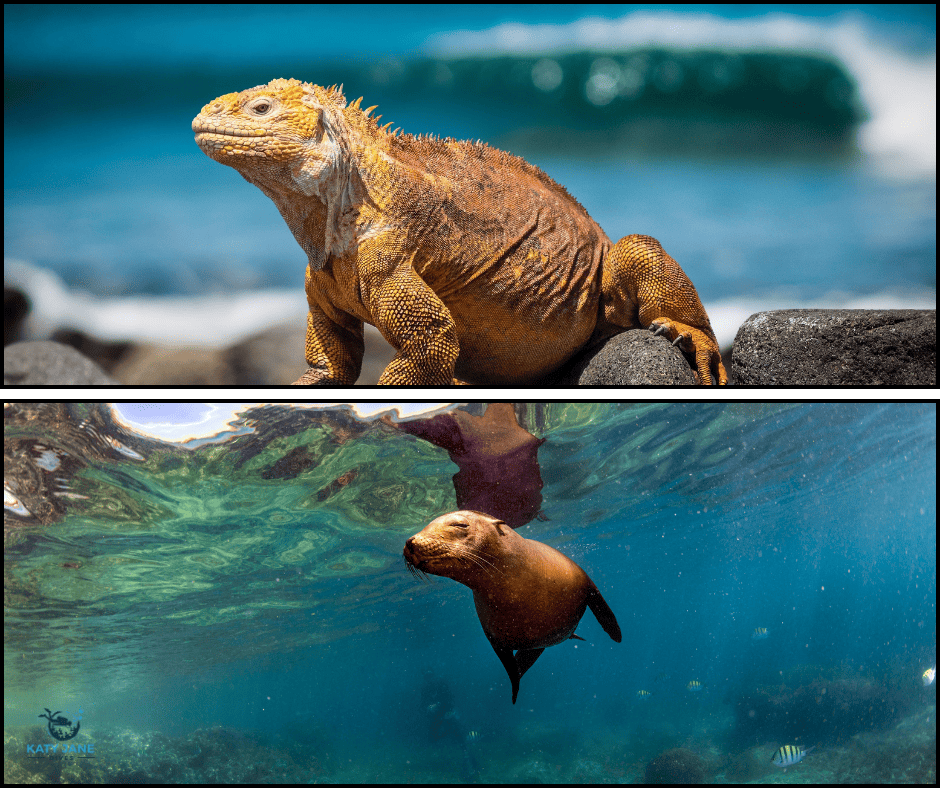
The Galapagos Islands, a beacon of biodiversity and evolutionary science, have been under conservation efforts for decades to protect its unique ecosystem and myriad of species found nowhere else on Earth.
The Galápagos Conservancy, since its inception in 1985, has been a pivotal force in these efforts, dedicating itself exclusively to the preservation and restoration of the islands. It collaborates closely with the Galápagos National Park Directorate and other partners to safeguard endangered species and rewild the archipelago’s complex ecosystems.
World Wildlife Fund (WWF) has also played a significant role in the islands’ conservation, supporting initiatives like the creation of the Galápagos Marine Reserve in 1998. This reserve, established with the support of the Ecuadorian government, has been critical in protecting the marine biodiversity that Charles Darwin once studied, allowing for sustainable fishing and tourism that benefit both the local economy and the islands’ numerous endemic species.
Innovative financing methods have been explored to ensure the ongoing protection of the Galapagos.
For instance, Ecuador has engaged in a debt conversion deal, converting $1.6 billion in commercial debt into a loan with a conservation finance commitment, creating a substantial, dedicated fund for conservation efforts. This approach aims to strengthen management, monitoring, and enforcement within the marine reserves, supporting sustainable fisheries, climate resilience, and the blue economy.
The Galapagos Conservation Trust outlines a strategic focus for 2023-2025, emphasising island restoration and ocean protection. Efforts will concentrate on eradicating invasive species, reducing human impact, and building climate resilience to protect marine biodiversity. This strategy includes fostering sustainable practices among local communities and promoting conservation education.
These concerted efforts by various organisations underscore a global commitment to preserving the Galapagos Islands, not only for their inherent ecological value but also for their importance to humanity’s understanding of nature and evolution.
I strongly encourage you to engage in citizen science during your visit to the Galapagos.
Choose a dive centre or liveaboard that actively supports research initiatives.
During my time on board the Galaxy Diver, we had the opportunity to participate in Shark Count, a valuable conservation effort.
The data you collect is incredibly valuable and contributes to our understanding of marine ecosystems.
Make your dive experience even more meaningful by becoming a citizen scientist and contributing to the preservation of these extraordinary environments.
Other Things to Do in Galapagos
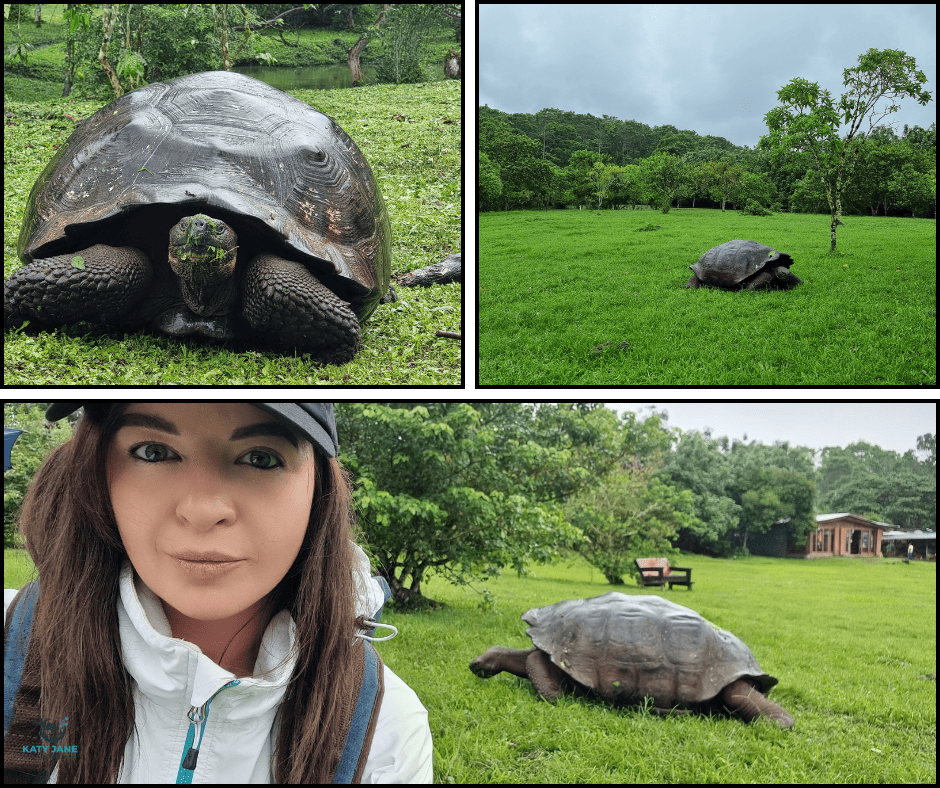
Venturing beyond the underwater realm of the Galapagos Islands exposes one to a treasure chest of exceptional activities. This paradise in the Pacific Ocean is not just rich in marine species but also presents a fascinating spectacle on the surface.
Flanked by the UNESCO World Heritage site tag, Galapagos offers its visitors a chance to walk amongst its endemic land animals.
On Santa Cruz Island itself, within a mere 30-minutes walk from the town, lies a capacious habitation of giant tortoises and iguanas. Besides, Galapagos is also dotted with volcanic islands which promise stunning natural beauty and trails for those keen on hiking.
Land-based tours to these volcanic landscapes, pristine beaches, and historic sites offer insight into the islands’ geological and human history. For those seeking adventure, activities such as kayaking, paddleboarding, and surfing are also popular options.
With its rich natural beauty and diverse array of experiences, the Galapagos Islands offer something for every type of traveller to enjoy.
Galapagos Liveaboards & Dive Resorts
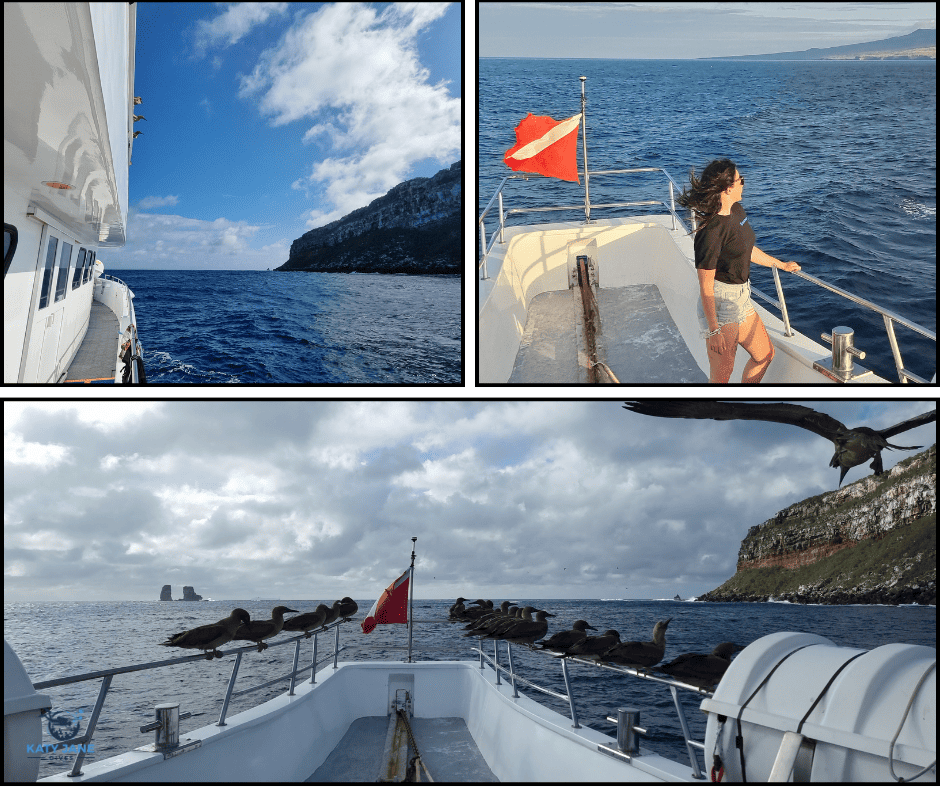
When it comes to exploring the breathtaking marine life of this UNESCO World Heritage Site, opting for a liveaboard is truly the way to go. It’s about getting front-row access to the vibrant treasure trove of oceanic wonders surrounding these volcanic islands.
Rather than a typical, land-based vacation, Galapagos liveaboards offer an immersive and comprehensive dive experience. Most of the prime diving sites, like the famed Darwin Island, flaunt a diverse ecosystem and a wealth of unique marine species.
The sheer variety earmarks these sites irresistible, yet a majority of them are inaccessible from the land. Liveaboards bridge this gap, meaning divers don’t find themselves missing out on an astonishing array of marine life.
They can expect encounters with playful sea lions, graceful manta rays, darting silky sharks and elegant eagle rays in these waters. The islands are also known for hosting whale sharks in abundance, especially around Darwin Island.
And let’s not forget the thrill of swimming with hordes of hammerheads, a unique spectacle that attracts divers globally to these Ecuadorian waters.
I am thrilled to partner with a highly reputable agent offering scuba liveaboards and naturalist cruises across the Galapagos Islands.
Please contact me to arrange your dream trip to the Galapagos Islands!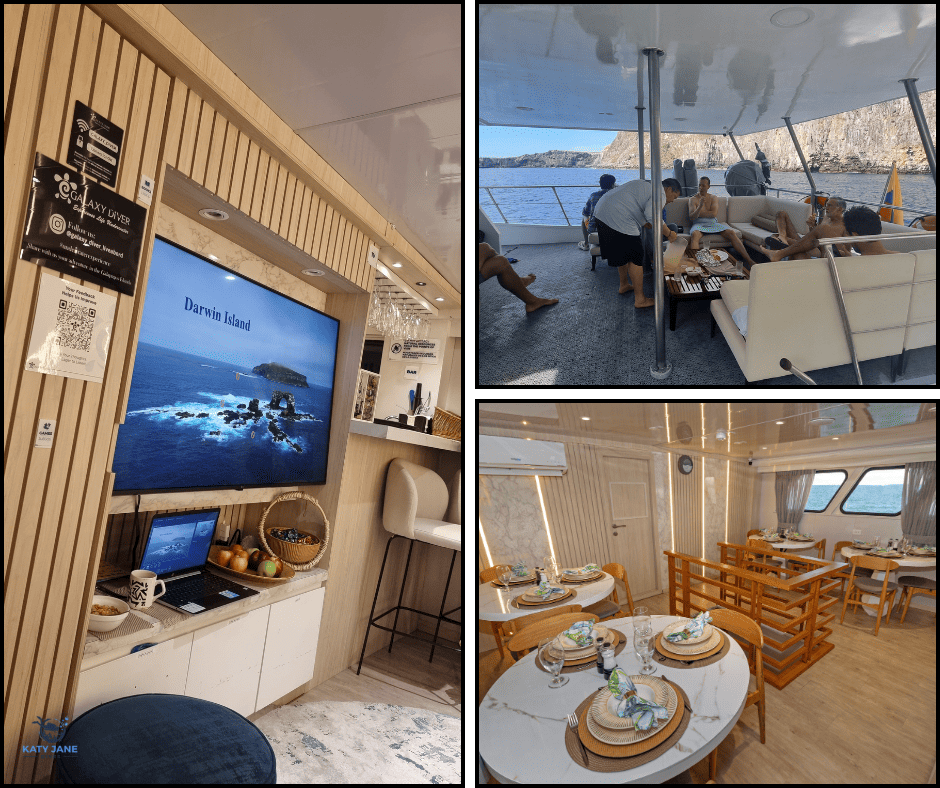
But it’s not just the dive sites that make liveaboards attractive. Featuring a blend of comfort and premium service, these boats enhance the dive holiday experience significantly. However, the prime season sees high demand, and availability can be scarce. To avoid missing out, one should consider booking the liveaboard at least 12 months in advance.
Among the many options for diving in the Galapagos, the ease and exposure provided by the Galapagos liveaboards make them a magnet for serious scuba divers. And while the charm of the Galapagos is not limited to its underwater marvels, the richness and diversity of its marine life are certainly among its strongest lures.
Other Dive Destinations
Is Galapagos Diving Worth It?
Diving in the Galapagos Islands offers an unparalleled experience that, in my opinion, is absolutely worth it.
After spending a week exploring these islands on a liveaboard, I’ve come to understand why it’s heralded as one of the top diving destinations globally. The biodiversity under the waves is staggering; in a single dive, I encountered more species than in my entire diving life. This rich tapestry of marine life, coupled with the thrill of swimming alongside the majestic mega fauna, truly sets the Galapagos apart.
The islands challenge divers with their strong currents, but these are exactly what bring the incredible array of life to the waters, making each dive a unique adventure. Encountering the massive schools of fish, playful sea lions, and the iconic hammerhead sharks in their natural habitat is a diver’s dream come true.
It’s an exhilarating reminder of the raw power and beauty of nature, making every effort to reach and dive in these waters unquestionably worthwhile. For any avid diver, the Galapagos Islands are a must-visit destination, offering unforgettable encounters that highlight the sheer wonder of the underwater world.
Conclusion
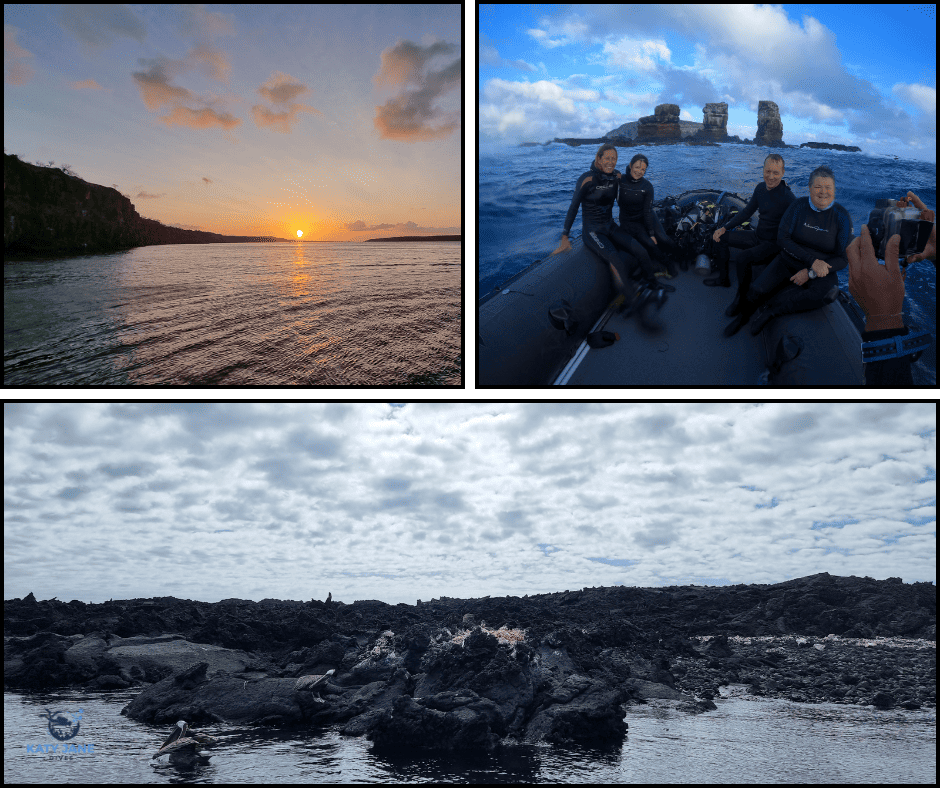
After experiencing the wonders of diving in the Galapagos Islands firsthand, I can wholeheartedly attest to the awe-inspiring beauty and incredible marine life that awaits beneath the waves.
From swimming alongside majestic hammerhead sharks to marvelling at coral reefs teeming with life, every moment spent exploring these pristine waters was truly unforgettable.
The sense of wonder and exhilaration that comes with diving in such a pristine and remote location is really special, and I urge anyone with a passion for adventure and discovery to embark on a liveaboard trip to the Galapagos without hesitation.
Trust me, the memories you’ll make and the sights you’ll see will stay with you for a lifetime. Book your trip now and prepare to be amazed – you won’t be disappointed!
